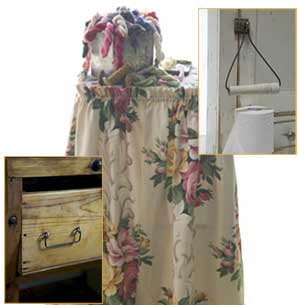



For my birthday, I wanted to set dozens of bouquets of daffodils and other spring flowers in all the buildings at my farm. Since I’m not a collector of vases, I got to looking at all my old galvanized feed buckets. But because they’re usually wider at the top, they require too many flowers to make a rounded display. So I put my thinking cap on. I grabbed a pair of gloves and wire cutters and started fashioning flower frogs using bunched-up chicken wire. When I was done, it was farmgirl style at its best.
Being an inventor isn’t difficult. If you stop to think about it, you’ve probably invented a long list of household items by now. Remember that purse you customized with a bit of Velcro, or that hidden coat pocket put just so with a needle and thread? How about that extra grommet you installed on the side of your backpack, creating the perfect place for keeping your camera handy? And those drawer handles fashioned from two screw eyes and wire? Don’t forget that clever coat-hanger device that held your reading lamp for bedtime books or that toilet-paper holder you made from the rung of a discarded chair.
For rural women, necessity is the mother of invention. Being imaginative and making-do is just part of the job. Actually, it is the job. It comes with the territory. Not only are stores sometimes hours away, but frittering away money on things you can make yourself will most certainly run a farm short of money.
Make-do inventions can also be a physically fit way to keep your brain in shape, much like taking up the habit of completing crossword puzzles, only better.
In the early 1900s, Beulah Louise Henry, also known as “Lady Edison,” applied for fifty-two patents in her name.
A native of Memphis, Tennessee, Beulah moved to New York City in 1919. Beulah lived her life according to an
Albert Einstein maxim: “Imagination is more important than knowledge.”
“I know less than nothing about the laws of physics, mechanics, or chemistry,” said Beulah, after patenting the protograph, an invention that made four typewritten copies without carbon paper. She also invented the bobbinless sewing machine, a “Dolly Dip” sponge that had a bar of soap inside, and the “Miss Illusion” doll, whose hair and eyes changed color.
Her most profitable invention was an umbrella with snap-on cloth covers that allowed a woman to change its fabric to a color that would match her wardrobe. “With a stone for a workbench and a hammer and nails for implements,” she told American magazine in 1925, “I made a hole in the top of that steel rib. Then I got a cake of soap and a nail file, and modeled the style of the snapper that would be strong enough to do duty on a windy day.”
Hazel Hook Waltz invented the bobby pin in 1916; and Gay Nineties well-known musical talent Lillian Russell patented a special folding dresser trunk with five drawers, lights, hooks, brackets, hinges, and mirrors, “that would answer all the requirements of an actress … also to be used by the traveling public and campers.”
Women’s everyday ingenuity continues to this day. Janna Collins recently designed a shopping-cart-handle cover that made her a bundle of money for her little germ-free bundle of joy, after seeing a man sneeze all over the handles of a cart she was about to grab.
But when it comes to being the mother of invention, don’t think only in terms of needle and thread, nuts and bolts. My mother used to say to us “Where’s your mother wit?” when our imaginations stalled. She was saying, “Go for it! You can find a way.”
When we dug the basement of my new home, I was left with a huge mound of clay that would need hundreds of soil-holding plants and shrubs. The nursery bill would have put me in the poor house. So over the course of several weeks, I went visiting my neighbors with a shovel and an empty truck,
bringing home hundreds of free starts—lilac trees, rosebushes, comfrey plants, iris rhizomes, and ground covers. Now, I don’t have just any rose bush. I have Ivan’s rose bush, right alongside Leatha’s lilacs and Brenda’s comfrey.
Old-fashioned common sense and gumption can solve most any problem, fill any void. The next time something isn’t quite right, put your thinking cap on.